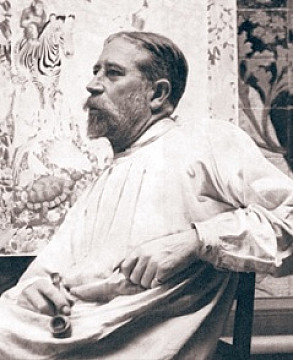Percyval Tudor-Hart (1873-1954)
(Ernest) Percyval Tudor-Hart, Artist & Sculptor, of Paris, London & Quebec
He was born and brought up in Montreal, but on his mother's side he was a grandson of the "Ice King" of Boston, Frederic Tudor. He travelled to Paris with the idea of studying medicine but ended up studying art at the prestigious Académie Julian before graduating from the École des Beaux-Arts where he was described as "rebellious" but developed a close working relationship with his esteemed professor, Jean-Léon Gérôme. He became a close friend of Henri Matisse and shared a studio in Montmartre with Toulouse-Lautrec. As an artist and sculptor, he exhibited across France winning gold and silver medals at the Paris Salon, but became best-known as a teacher.
From 1903 to 1917, he ran "Tudor-Hart's Académie de Peinture" at 69 Rue d'Assas in Paris and after the death of his first wife moved the school to Hampstead in London. He developed a reputation for restoring masterpieces, among them a Gainsborough, a Raeburn, a Kneller, a Corot, and four portraits by Gilbert Stuart. As a teacher, he had a reputation of being courteous but austere, and a hard taskmaster, as related in the memoirs of several former students. In England, he exhibited at the Royal Academy and the Walker Art Gallery in Liverpool, specialising on the theory of colour, particularly the correspondence between colour and music tone. During WWI, he became an early exponent of camouflage, proposing to the military that they use geometrical patterns with alternating stripes of warm and cold colors graded according to the area covered. Aside from drawing up designs for tanks and boats, he fabricated sniper's gloves too.
He was married three times (1) In Paris, he married his first cousin Countess Nellie Kleczkowska, daughter of his aunt, Countess Euphemia (Tudor) Kleczkowska. They were the parents of three children (2) In London, 1921, Nancy, daughter of Francis Gardiner Richards, of Boston & Gardiner, Maine. She was another cousin, being a great-grand-daughter of Emma (Tudor) Gardiner, of Oaklands, sister of the "Ice King" and her parents were in the circle of Henry James. (3) In Quebec, 1935, Catherine, only daughter of Godfrey William Rhodes, and heiress to Cataraqui where he lived from then until his death, taking up an interest in horticulture and landscaping. He was a great admirer of Charles de Gaulle and gave financial support for the Free France movement in Quebec. In 1943, the Museum of Quebec held a retrospective exhibition of his work.
From 1903 to 1917, he ran "Tudor-Hart's Académie de Peinture" at 69 Rue d'Assas in Paris and after the death of his first wife moved the school to Hampstead in London. He developed a reputation for restoring masterpieces, among them a Gainsborough, a Raeburn, a Kneller, a Corot, and four portraits by Gilbert Stuart. As a teacher, he had a reputation of being courteous but austere, and a hard taskmaster, as related in the memoirs of several former students. In England, he exhibited at the Royal Academy and the Walker Art Gallery in Liverpool, specialising on the theory of colour, particularly the correspondence between colour and music tone. During WWI, he became an early exponent of camouflage, proposing to the military that they use geometrical patterns with alternating stripes of warm and cold colors graded according to the area covered. Aside from drawing up designs for tanks and boats, he fabricated sniper's gloves too.
He was married three times (1) In Paris, he married his first cousin Countess Nellie Kleczkowska, daughter of his aunt, Countess Euphemia (Tudor) Kleczkowska. They were the parents of three children (2) In London, 1921, Nancy, daughter of Francis Gardiner Richards, of Boston & Gardiner, Maine. She was another cousin, being a great-grand-daughter of Emma (Tudor) Gardiner, of Oaklands, sister of the "Ice King" and her parents were in the circle of Henry James. (3) In Quebec, 1935, Catherine, only daughter of Godfrey William Rhodes, and heiress to Cataraqui where he lived from then until his death, taking up an interest in horticulture and landscaping. He was a great admirer of Charles de Gaulle and gave financial support for the Free France movement in Quebec. In 1943, the Museum of Quebec held a retrospective exhibition of his work.










